RETURN
TO . . .
Emsworth
Wildlife - Homepage
ISLE
OF WIGHT
Wildlife
Reports from vsits to the
island
. . .
May
17 to May 22 - 2016
Jean and I spent a few
days on the Isle of Wight staying with our son, Peter,
and his family at Cowes. The weather was rather mixed
and I did not have much opportunity for wildlife
watching. However, Peter was able to take me to see a
couple of interesting things that I had not seen
before.
The first was my first
ever Greater Butterfly Orchids in Walters Copse
near to the Newtown Nature Reserve. Six of them were
in flower in the copse. Greater Butterfly Orchid is a
rare flower, listed as 'Near Threatened'. It is
sparsely distributed on the Isle of Wight. The photo
on the left shows a spike of flowers, not fully open.
The photo on the right shows an open flower with the
distinctive long spur.
Although they were
well past their best I was pleased Peter was able to
take me to Eaglehead Copse near Sandown to see
Toothwort. There were still a lot of spikes on
show in the woods, we saw at least 100. This was one
of the best.
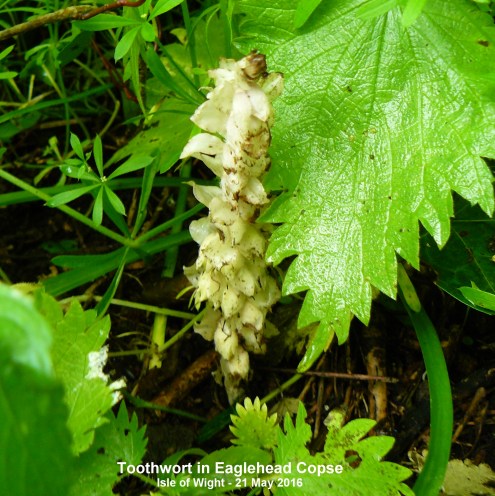
While walking through
Eaglehead Copse my son spotted a young Tawny
Owl on the ground, looking quite well and healthy.
We were a little concerned for its safety, but were
reassured by a wildlife expert that the youngster will
almost certainly be able to climb back up the tree.
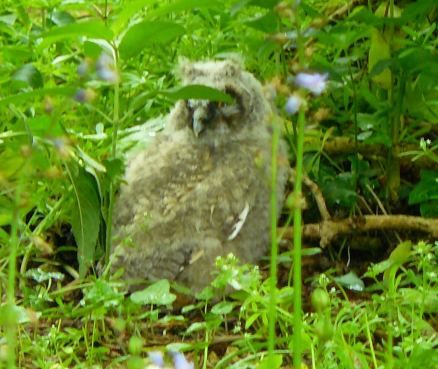
Jean and I paid a
visit to Ventnor Botanical Gardens where it was good
to see the Wall Lizards were still present in
the despite the change in ownership.
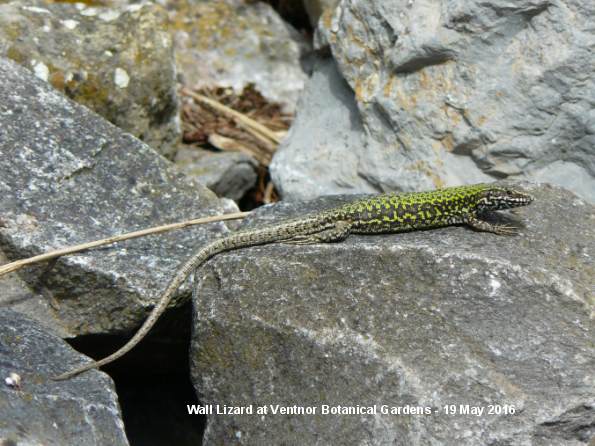
MONDAY APRIL 4 - 2016
Toothwort
My son, Peter
sent me this photo of Toothwort which he took
yesterday during a family walk through Eaglehead Copse
on the Isle of Wight. Personally, I have never seen
this plant and I look forward to going over to the
island in the next few weeks while the plants are
still present.
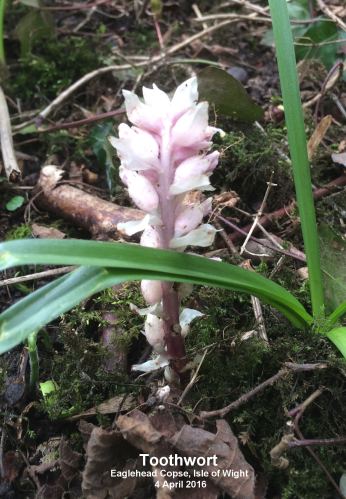
The article in the
current issue of the magazine 'Wildlife' from the
Hampshire Wildlife and Isle of Wight Trust highlights
Eaglehead Copse as the best place on the Isle of Wight
to see this unusual plant. The Isle of Wight Flora
(Pope, Snow and Allen) describes Toothwort as locally
frequent in woods on chalk or heavy clay soils and
says that Eaglehead Copse can hold over 2,000 plants,
in three different colour forms, white (the most
common), lemon-yellow and beetroot red. The Hants
Flora shows no records in our area at all; most are in
North Hampshire.
Toothwort is a member
of the Broomrape family which are parasites on various
plants and have leaves reduced to scales with no
chlorophyll and are hence not green. Toothwort has
tubular flowers in one-sided spikes up to about 25 cm
which die down quickly after flowering. It gets it
name from the flowering spikes which resemble rows of
teeth. It is parasitic on mostly Hazel and Elm.
29
June to 3 July - 2015
Kittenocks
Meadow - Thursday July 2nd 2015
My son Peter
took me to have a look at this privately owned meadow
near Havenstreet on the Isle of Wight. There is
strictly no access to the site without permission.
Kittenocks, in fact, comprises two meadows, plus a
small streamside and semi-natural woodland. The whole
site is designated a SINC. It was surveyed by the Isle
of Wight Natural History Society in 2009. Pete and I
did a circuit of the two meadows in about 2 hours,
noting the plants as we went. We did not look at the
woodland or the stream.
Here
is Pete (6 feet plus) standing beside one of the very
tall Marsh Thistles
with the meadow in the background
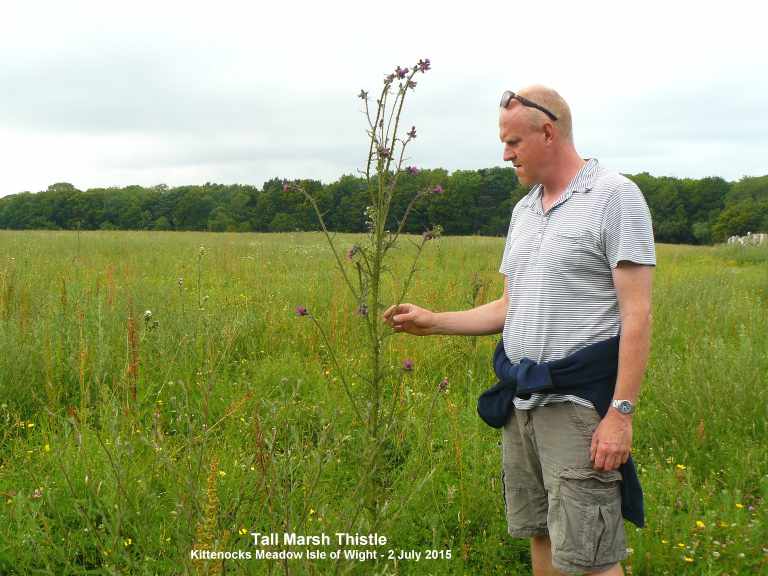
Both meadows were very
beautiful with low growing grasses and masses of wild
flowers. Most impressive were the orchids, Common
Spotted and Southern Marsh plus swarms of
hybrids (Dactylorhiza x grandis) which
were mostly in the second meadow.
Here
is a view of the hybrids on the second meadow
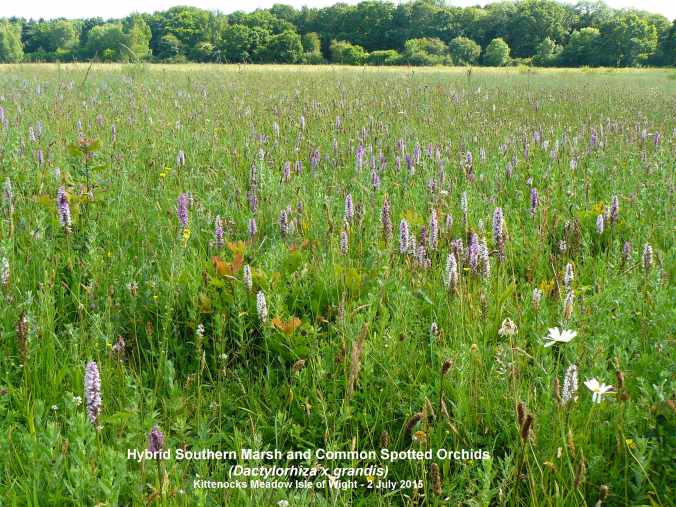
The hybrids were
puzzling as they looked like Southern Marsh Orchids,
but had spotted leaves. The Isle of Wight Flora
indicates that these hybrid orchids are frequent in
marshy sites.
Here
is a possible Dactylorhiza x grandis
flower spike
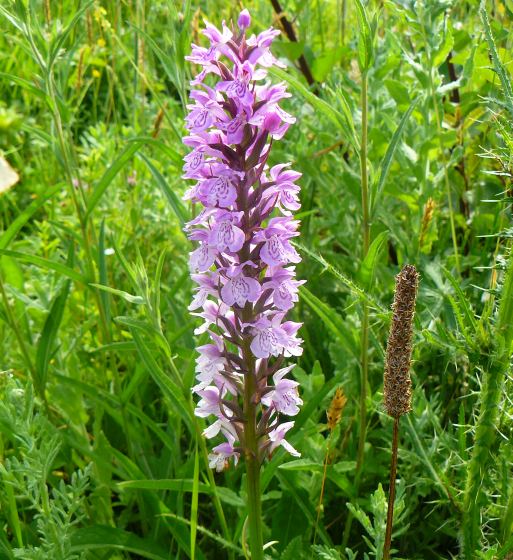
And a
Southern Marsh Orchid (I think) for
comparison

The Bird's-foot
Trefoils were also puzzling as I think we had both
Common Bird's-foot Trefoil and Greater Bird's-foot
Trefoil which were tricky to sort out as many were
going to seed.
Here
is what I think are Common Bird's-foot Trefoil seed
pods
The arrangement is what gives the plant its common
name
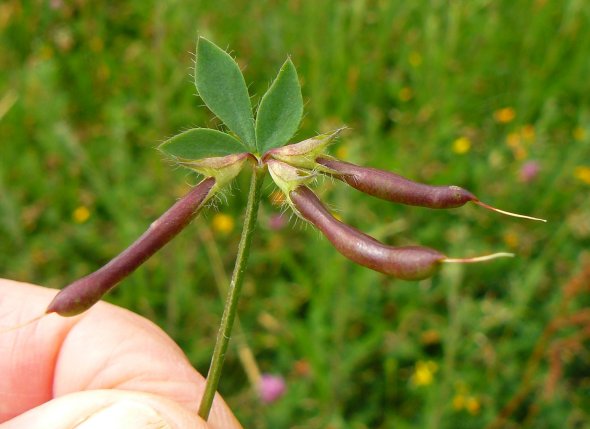
Large
patches of yellow flowered Dyers Greenweed
adorned the second meadow

Common
Vetch (left) was fairly common. Grass Vetchling
(right) less common
We
found just one spike of Marsh Woundwort just
starting to flower

The wild flowers
attracted masses of butterflies and other insects.
There were literally hundreds of Meadow Browns
and Marbled Whites fluttering around and
feeding on the flowers. We also saw a Short-winged
Conehead - female if that dark spike on the photo
is an ovipositor.
There
were also hundreds of Burnet Moths, both 5-spot
(left) and 6-spot (right)
, mainly clearly just emerging from their
chrysalis
Here is a complete
list of plants noted during our walk round the
meadows. N = 58 species.
The final column shows those which were also found
during the 2009 Natural History Society survey.
There are a few plants we recorded that the 2009
survey did not ie Black Medick, Cat's-ear, Compact
Rush, False Fox Sedge,Meadowsweet and Spear
Thistle
|
COMMON
NAME
|
SCIENTIFIC
|
2009
Survey
|
|
Black
Medick
|
Medicago
lupulina
|
.
|
|
Blackthorn
|
Prunus
spinosa
|
1
|
|
Bramble
sp
|
Rubus
ulmifolius
|
1
|
|
Cat's-ear
|
Hypochaeris
radicata
|
.
|
|
Cocksfoot
|
Dactylis
glomerata
|
1
|
|
Common
Bent
|
Agrostis
capillaris
|
1
|
|
Common Bird's-foot
Trefoil
|
Lotus
corniculatus
|
1
|
|
Common
Fleabane
|
Pulicaria
dysenterica
|
1
|
|
Common
Knapweed
|
Centaurea
nigra
|
1
|
|
Common
Sorrel
|
Rumex
acetosa
|
1
|
|
Common Spotted
Orchid
|
Dactylorhiza
fuchsii
|
1
|
|
Common
Vetch
|
Vicia
cracca
|
1
|
|
Compact
Rush
|
Juncus
conglomeratus
|
.
|
|
Corky-fruited
Water-dropwort
|
Oenanthe
pimpinelloides
|
1
|
|
Creeping
Bent
|
Agrostis
stolonifera
|
1
|
|
Creeping
Buttercup
|
Ranuculus
repens
|
1
|
|
Creeping
Cinquefoil
|
Potentilla
reptans
|
1
|
|
Creeping
Thistle
|
Cirsium
arvense
|
1
|
|
Curled
Dock
|
Rumex
crispus
|
1
|
|
Dog
Rose
|
Rosa
canina
|
1
|
|
Dyers
Greenweed
|
Genista
tinctoria
|
1
|
|
False Fox
Sedge
|
Carex
otrubae
|
.
|
|
False
Oat-grass
|
Arrhenatherum
elatius
|
1
|
|
Field
Bindweed
|
Convolvulus
arvensis
|
1
|
|
Field
Horsetail
|
Equisetum
arvense
|
1
|
|
Glaucous
Sedge
|
Carex
flacca
|
1
|
|
Grass
Vetchling
|
Lathyrus
nissolia
|
1
|
|
Great
Willowherb
|
Epilobium
hirsutum
|
1
|
|
Hairy Tare
|
Vicia
hirsuta
|
1
|
|
Hard
Rush
|
Juncus
inflexus
|
1
|
|
Hawthorn
|
Crataegus
monogyna
|
1
|
|
Hedge
Bedstraw
|
Galium
mollugo
|
1
|
|
Hoary
Ragwort
|
Senecio
erucifolius
|
1
|
|
Hogweed
|
Heracleum
sphondylium
|
1
|
|
Hybrid
Orchid
|
Dactyllorhiza x
grandis
|
1
|
|
Lesser
Stitchwort
|
Stellaria
graminea
|
1
|
|
Marsh
Thistle
|
Cirsium
palustre
|
1
|
|
Marsh
Woundwort
|
Stachys
palustris
|
1
|
|
Meadow
Buttercup
|
Ranuculus
acris
|
1
|
|
Meadow
Foxtail
|
Alopecurus
pratensis
|
1
|
|
Meadow Vetchling
|
Lathyrus
pratensis
|
1
|
|
Meadowsweet
|
Filipendula
ulmaria
|
.
|
|
Oxeye
Daisy
|
Leucanthemum
vulgare
|
1
|
|
Pedunculate Oak
(seedlings)
|
Quercus
robur
|
1
|
|
Red
Clover
|
Trifolium
pratense
|
1
|
|
Ribwort
Plantain
|
Plantago
lanceolata
|
1
|
|
Selfheal
|
Prunella
vulgaris
|
1
|
|
Silverweed
|
Potentilla
anserina
|
1
|
|
Smooth
Brome
|
Bromus
racemosus
|
1
|
|
Smooth Tare
|
Vicia
tetrasperma
|
1
|
|
Southern Marsh
Orchid
|
Dactylorhiza
maculata
|
1
|
|
Spear
Thistle
|
Cirsium
vulgare
|
.
|
|
Square-stalked St
John's-wort
|
Hypericum
tetrapterum
|
1
|
|
Sweet Vernal
Grass
|
Anthoxanthum
odoratum
|
1
|
|
Timothy
|
Phleum
pratense
|
1
|
|
Tufted
Vetch
|
Vicia
cracca
|
1
|
|
White
Clover
|
Trifolium
repens
|
1
|
|
Yorkshire
Fog
|
Holcus
lanatus
|
1
|
Other
observations
Sea
Slater
While we were
all walking along the promenade of West Cowes the
girls spotted a large wood louse type creature
scuttling over the concrete foreshore towards the sea.
It was much larger than the common wood louse one
finds in gardens and it moved much faster.
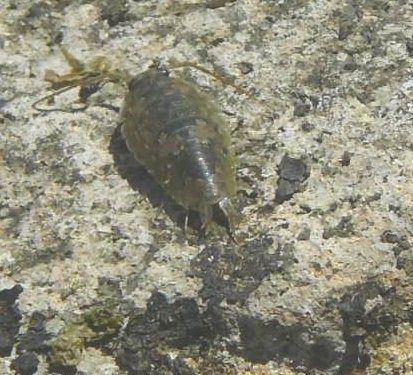
I had a look in my
Collins Guide to Insects by Chinnery when I got home
and located it as Sea Slater - Ligia
oceanica. Wood lice are land-living
crustaceans of the order Isopoda and have seven pairs
of walking legs. Most are scavengers among dying
vegetation as are Sea Slaters on the rocky shores.
Water
Bent
I was on the
look out for any pavement grasses like I recently
found in Emsworth and I found a good growth of Water
Bent in a neglected front garden in St Mary's Road
Cowes.
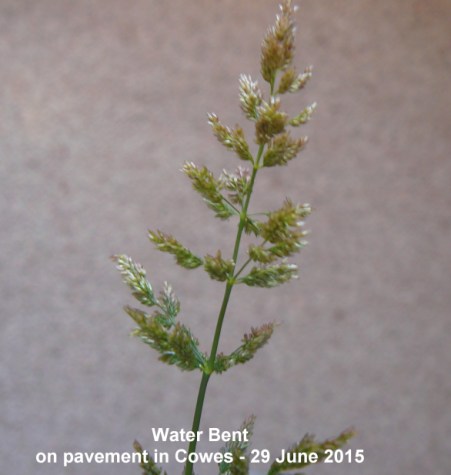
The Isle of Wight
Flora describes Water Bent (Poypogon viridis)
as 'A rare but increasing casual grass of waste
ground'.
ISLE
OF WIGHT - May 2013
Jean and I were on the
Isle of Wight from Wed May 8 to Sun May 12 visiting
Pete and Julia and Lily and Iris in Cowes. The weather
was not good while we were there, but I managed to get
to a few of my favourite spots.
SUNDAY
MAY 12- 2013
Walter's
Copse
Jean and I had a fine
walk through Walter's Copse with Pete and Lily and
Iris. I had forgotten how good this woodland was.
Bluebells were looking fine in the woodlands and there
was also lots of Bugle (no doubt about its
identification) along with a few Early Purple Orchids
and Wood Spurge. We went a little way onto the
saltmarshes where English Scurvygrass and the first
Thrift were in flower.
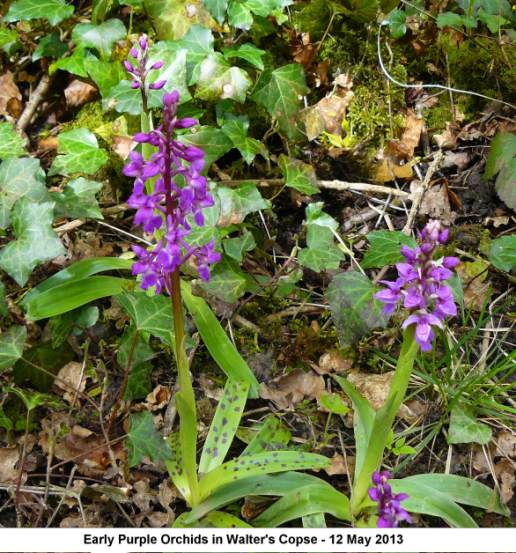

We met a couple
looking for the Large Tortoiseshell which had been
seen in Walter's Copse again. They thought it could
have been over wintering, but it might have been
released by enthusiasts. The girls were great and
loved racing around and picking flowers and leaves.
Heath
Wood-rush
I as particularly
pleased to find another new Wood-rush for me along the
main track. It was in tufts and much taller than Field
Wood-rush with straight stiff stems and larger hairier
leaves. I tentatively identified it as Heath Wood-rush
(Luzula multiflora ssp. multiflora), though some of
the inflorescences were very compact which reminded me
of Dense-headed Heath Wood-rush (Luzula multiflora ssp
congesta).
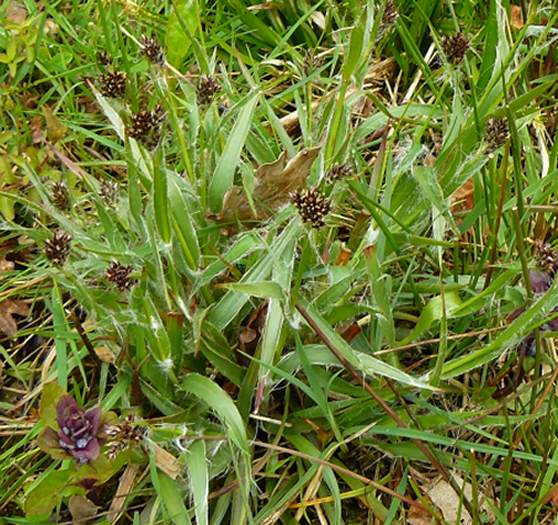
SATURDAY
MAY 11- 2013
Northwood
Cemetery
Pete, Jean, Lily and
Iris and I walked round Northwood Cemetery this
morning. We saw lots of wild flowers among the graves
and the girls made a nice collection. The cemetery has
a beautiful setting to be buried. I found more
Southern Wood-rush with an open V-shaped
inflorescence. This plant is certainly common on the
Isle of Wight. Other interesting flowers included
Bulbous Buttercup, Wood Anemone, Common Dog-violet,
Primrose, Bluebells, Bugle (not Self-heal),
Green-winged Orchids (just a few), Common Sorrel,
Common Stork's-bill, Common Mouse-ear, Meadow Foxtail,
Sweet Vernal Grass.
I realised that I had
been identifying Bugle as Self-heal. I'm sure the
plants we saw at Newtown Nature Reserve yesterday were
Bugle as were those at Northwood Cemetery today. I was
mistaken in thinking that Bugle was purely a woodland
plant, but it also grows on grassy places. Also,
Self-heal has violet flowers not blue and it does not
flower until June.
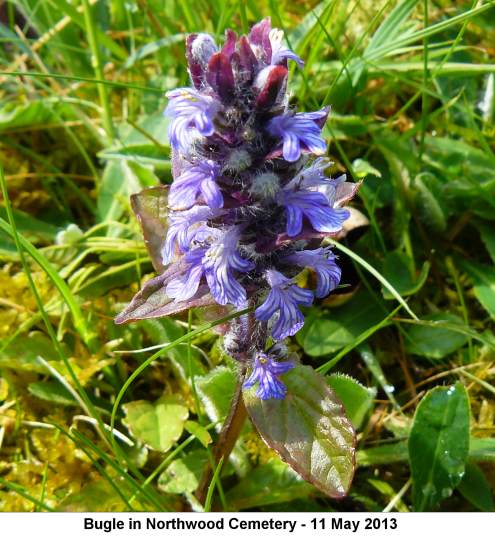
FRIDAY
MAY 10- 2013
Newtown
Nature Reserve
Jean and I stopped at
the Newtown Nature Reserve mainly to have a look at
the Green-winged Orchids on the main meadow, but there
were hardly any out. We went round the meadow, but
could only find 8 flower spikes where as there are
usual several hundred.

In fact, there was
surprisingly little growth of plants on the meadow at
all. Flowering plants included Self-heal, Meadow
Buttercups and Common Sorrel. The only grasses I could
see were Meadow Foxtail and Sweet Vernal Grass, plus
Glaucous Sedge and Field Wood-rush. Lots of Alexanders
was out on the roadside verges.
Fort
Victoria Country Park
Jean and I walked part
of the way around the nature trail which was very good
for ferns including lots of fresh Hart's-tongue Fern
unfurling.
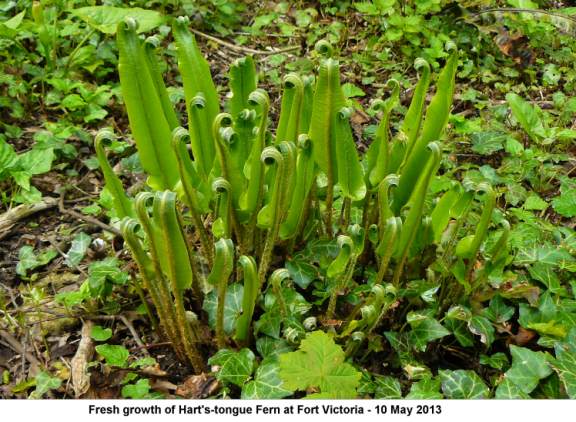
There was a good
flowering of Sanicle on the edge of the man path.
Other plants of interest included Wood Sedge, Wood
Speedwell and Wavy Bitter-cress.

THURSDAY
MAY 9- 2013
Borthwood
Copse
On our way to Sandown,
Jean and I stopped off for a walk through Borthwood
Copse. This is a small mixed decidious ancient
woodland with lots of Holly and Honeysuckle. It is
owned by The National Trust and is a big dog walking
area. It is said to have Red Squirrels, but we did not
see any. There was a good showing of Bluebells and
Wood Anemones but not special. However, we found some
patches of Wood-sorrel with its distinctive trefoil
leaves, though the flowers were not open at the time.
Pope says Wood-sorrel is very local on the island in
ancient woodlands.
Southern
Wood-rush
More interesting, was
the Wood-rush which I found growing in several
locations in small tufts. The plants grew in small
tussocks and the inflorescences were branched which I
think rules out the common Field Wood-rush. One
possibility is Southern Wood-rush (Luzula forsteri)
which Rose says has a rather V-shaped inflorescence
and which Pope says is particularly frequent on the
island. In fact, I have found some previously in
Ventnor Botanic Gardens on 25-May-10. The other
possibility is Great Wood-rush (Luzula sylvatica)
which Pope says is present in Borthwood Copse, where
it is responding to recent management and 'plants are
springing up in many new clearings'. However, the
plants do not seem large enough for that.

WEDNESDAY
MAY 8 - 2013
Keeled-fruited
Cornsalad
As we walked down St
Mary's Road in Cowes, I noticed a front garden that
was completely covered with Cornsalad, growing on what
looked like broken slate. An amazing sight.

From Pope's Isle of
Wight Flora I assume this is Keeled-fruited Cornsalad
which they say is common and widespread over the
island, whereas Common Cornsalad is a rare plant of
cultivated and disturbed ground. Interestingly, Rose
(p.428) says Common Cornsalad is the commonest
Cornsalad, though from what Eric Clement told Ralph
Hollins, the default Cornsalad species in Hampshire is
V. carinata (ie Keeled-fruited Cornsalad) and not V.
locusta (Common Cornsalad). Keeled-fruited Cornsalad
is so-called after its deeply grooved and keeled
fruits.
ISLE
OF WIGHT April-May 2011
GURNARD
PINES - April 30 - May 6, 2011
Jean and I had a
family holiday on the Isle of Wight visiting my son
and his family. We rented a self-catering chalet for a
week at the Gurnard Pines holiday centre just outside
Cowes. Our chalet was very pleasant and quiet,
positioned near the edge of Raffins Copse. No dogs
were allowed on the estate due to the presence of the
protected Red Squirrel. I would highly recommend this
place.
Birds
I erected a sunflower
heart seedholder on a pine tree outside the chalet and
scattered seed on the ground. We had a variety of
birds during the week, including Blue Tit, Woodpigeon,
Carrion Crow, Greenfinch, Blackbird, Mistle Thrush,
Robin and Mallard. The Woodpigeon discovered a way of
reaching the seeds by perching on a nearby branch and
leaning across to the holder.
Red
Squirrel
However, best of all
was to have regular visits from a Red Squirrel to the
seed holder. Each morning, as we had breakfast, we had
the great pleasure of watching the squirrel through
the chalet window. It would also be there at various
other times during the day. Typically, the squirrel
would hang upside on the holder, seemingly sucking
seeds from the small exit holes. While doing this, it
showed its white underparts and also revealed a penis,
indicating the animal was a male.

On two days running
the squirrel managed to dislodge the seed holder onto
the ground from where it has easy access to the spilt
seeds. Clearly, it was a regular around the chalets as
it would race around others in the same area.
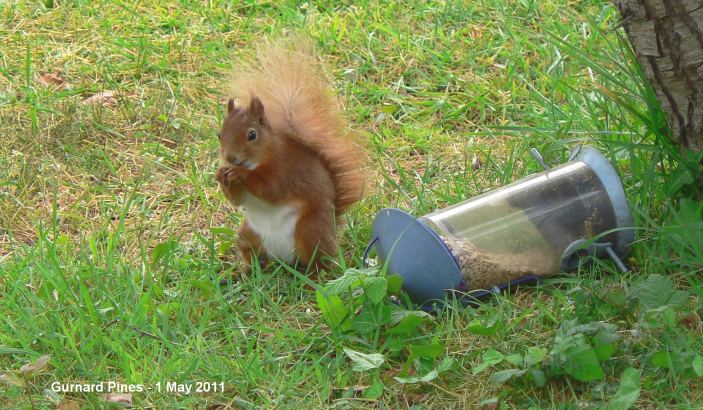
Young Rabbits
were also regular around the chalets.
HEATHLAND
RESTORATION - April 30, 2011
Saturday April
30. My son Peter (as Manager of the West Wight
Landscape Partnership) is involved with four important
heathland restoration projects in co-operation with
the Hampshire Wildlife Trust. He and I visited two of
them, Bouldner Copse and Ningwood Common. The other
restoration sites are at Mottistone Common and
Brightstone Common. In all these areas extensive tree
clearance has taken place to restore valuable
heathland habitat which is scarce on the Isle of
Wight.
Bouldner
copse
Bouldner Copse is a
large woodland with a heathland area close to the
cliffs overlooking The Solent. The heathland area is
being extended through tree clearance. HWT is also
planning to take over some old MOD buildings to
develop an education centre.
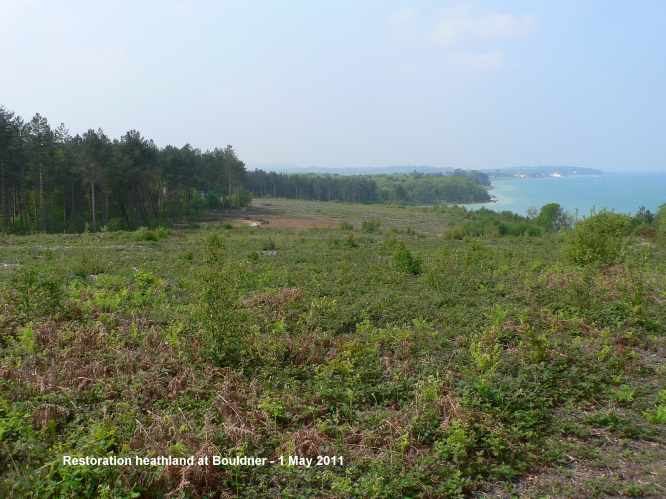
Ningwood
Common
Ningwood Common is
close to Bouldner Copse but further inland. Most of
the plants I found on Bouldner Copse were also on
Ningwood Common, though generally in greater numbers.
Restoration work has been taking place here over many
years and the area is more well established.
Heath
Violets
Most of the ground was
bare earth on the restoration sites, particularly
Bouldner which has been more recently worked on. There
are some interesting heathland plant specialities,
including Heath Dog Violets (Viola
canina) with yellow spurs and dark blue flowers
and the rare Pale Dog Violets (Viola
lactea) with very pale flowers - the first time I
have seen these Violets.
Tormentil was fairly
widespread. Common Milkwort was occasional. Gipsywort
was growing beside the pond in the woodland. Compact
Rush and Glaucous Sedge was widespread, plus some
Distant Sedge.
Here
is a Pale Dog Violet
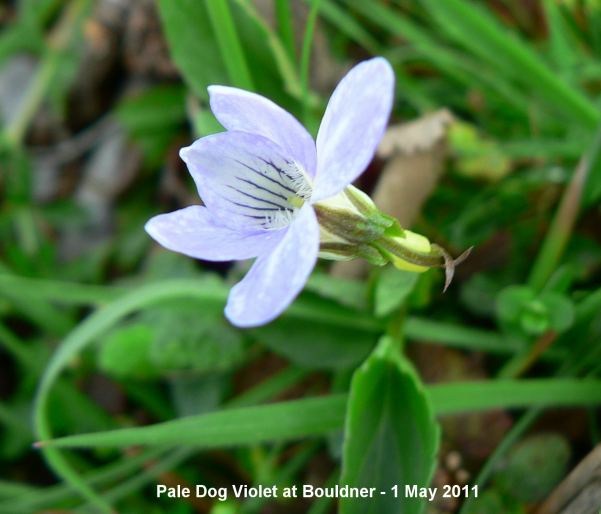
Common
Yellow Sedge
Most interesting was a
small tuft of sedge that I found in the centre of the
Bouldner heathland area. Each stem had a cluster of
female spikelets beneath a single male spikelet, with
a pair of bracts rising above the inflorescence. After
much deliberation (consulting Rose, The Flora of the
Isle of Wight, and the BSBI handbook on sedges), I
eventually decided on Common Yellow Sedge (Carex
demissa).
The plant is recorded
in the 'Isle of Wight Flora' in the Bouldner area, but
in that book is referred to as Carex viridula
whereas in Rose and the BSBI book it is Carex
demissa. I will ask Pete to pass my plant list and
photos onto Richard Grogan the HWT manager of the site
for him to check them with his records. I will also
check on the sedge with Island Ecologist Colin Pope.
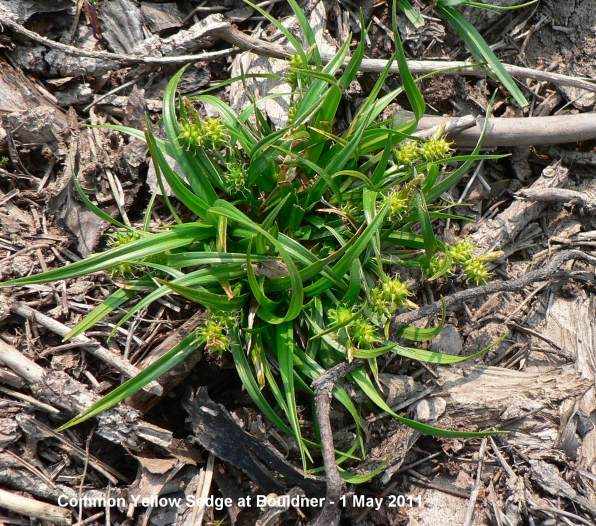
Butterflies
We came across
interesting butterflies near the cliff edge at
Bouldner. I saw the first fly past, an orange brown
colour, certainly not a Comma, more like a Fritillary.
When one finally settled the distinctive white
pupilled eye spot ruled out Fritillary and indicated
Wall Brown. This I confirmed later from the
photos. Bouldner is ideal habitat for the Wall Brown
with large areas of sun baked bare soil.

The second was a small
green butterfly which looked like a Holly Blue, but
when it settled it was clearly green. The only green
butterfly I knew about was the Green Hairstreak,
which a photo subsequently confirmed. Heathland is
also the habitat preferred by the Green
Hairstreak.

Other
insects
Several Small Heaths
were seen on Ningwood Common.
The fly-like moths
with very long antennae Adela
reaumurella were swarming around the shrubs
near the cliff edge at Bouldner.
Large Red
Damselflies were mating on the 'original pond' in
the woodland at Bouldner.
NEWTOWN
NATURE RESERVE - May 2, 2011
Monday May 2. I spent
this morning (a very windy one) with members of my
family looking around Newtown Nature Reserve. I have
visited this lovely reserve on several previous
occasions, but not in early May.
Plants
The main meadow
towards the harbour had hundreds of Green-winged
Orchids in flower and a fine sight they were too.
However, not so many I suspect as Hayling beach. I
spotted one white-flowered orchid. Also, in flower
were Yellow Rattle and Bird's-foot Trefoil.

On the eastern meadows
the large clumps of Dyers Greenweed were
showing well, but not yet in flower. I also saw my
first Lesser Stitchwort flowers of the year. I
was surprised to see a large number of
pink-flowered Bugle plants among the standard
blue flowers, something I have not seen before. They
looked rather like orchids.
I could just make out
some of the plantain-like flower spikes of
Mousetail in the usual spot near the cattle
trough in the field east of the Old Town Hall.
The long flower spikes
of Sea Arrowgrass were standing tall in the
saltmarshes beneath the boardwalk to the harbour hut.
Birds
The only bird of
special interest was a Lesser Whitethroat singing from
a hedgerow, my first of the year. There was no sound
of Nightingale in its regular place on the old High
Street. I could just make out Common and Sandwich
Terns on the islands in the harbour, but it was much
too windy for a good view.
GOLDEN
HILL - May 3, 2011
Tuesday May 3. Golden
Hill in Freshwater is another heathland restoration
project which is being funded by the West Wight
Landscape Partnership. I had a look around this
morning. Large areas of scrub clearance on the top of
the hill have taken place since my last visit last
summer, though there is still a long way to go before
it approaches the stage of restoration achieved at
Bouldner Copse and Ningwood Common. Interestingly, a
series of concrete steps have been revealed by the
clearance on the south side of the hill, no doubt
associated with the military fortifications.

Plants
There is Gorse in
plenty but little other obvious evidence of heathland
flora. Plants of interest in flower included
Silverweed, Bird's-foot Trefoil, Bugle
(including some pink-flowered previously found on
Newtown Nature Reserve) and Common Dog-violets, but no
Heath Dog Violet.
I found one Early
Purple Orchid in flower beneath an Oak tree. It was
good to see patches of Dyer's Greenweed on the
southern side of the hill. Ferns (probably Male Fern)
and Hard Rush were widespread, plus some Compact Rush
and Distant Sedge. There is an area of open grassland
on the west side of the hill with masses of Rosebay
Willowherb yet to flower
Birds
I heard my second
Lesser Whitethroat of the year.
OSBORNE
HOUSE - May 4 2011
Wednesday May 4. Jean
and I walked round the grounds of Osborne House this
morning. The walled garden was interesting with its
huge plants of Prince Albert Rhubarb allowed to
go to seed.
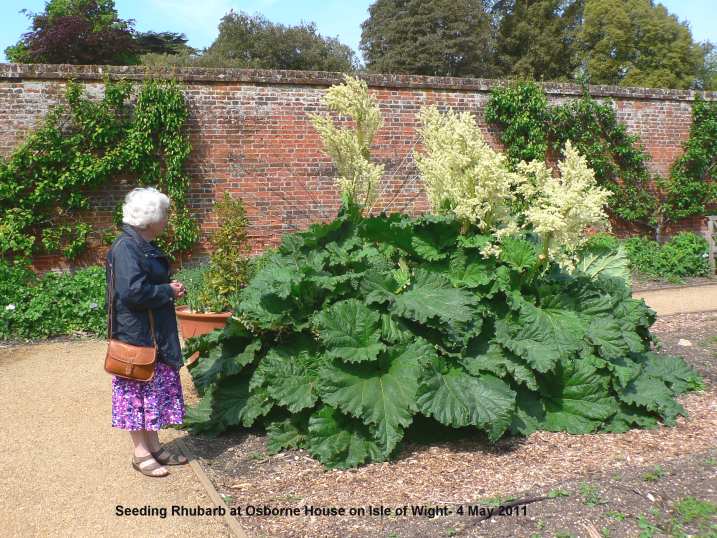
Another striking plant
was Fox-tailed Lily with its long white flower
spikes. The grassland was peppered with the pale
yellow daisies of Mouse-ear Hawkweed and the white
umbellifers of Pignut. Green-winged Orchids were
scattered here and there.
SHANKLIN
CLIFFS - May 5, 2011
Jean and I had a walk
along the cliffs at Shanklin in Mediterranean weather.
The flowers were excellent.
Lots of Musk
Stork's-bill (?) and Oxeye Daisies were in flower
along the top of the cliffs. I saw my first Yarrow of
the year in flower and also a white flowered Red
Valerian, which apparently is quite common, though I
do not recall having seen one before. Soft Brome,
Barren Brome and Red Fescue were the main grasses,
with a few deep red flowered Cocksfoot.
Great
Quaking Grass
However, my best
plants of the day was a luxurious growth of Great
Quaking Grass which was growing at the foot of the
cliffs near the stalls. In 'The Isle of Wight Flora'
(p.181) it is said to be "Generally recorded as a
non-persistent casual, but it is well established and
increasing in cliff top sandy grassland at Lake
Cliffs". Just in case these plants are not recorded I
will tell Botanical Recorder Colin Pope about them.
